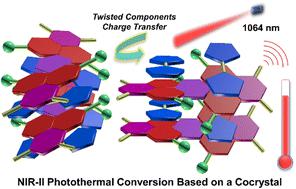当前位置:
X-MOL 学术
›
Chem. Sci.
›
论文详情
Our official English website, www.x-mol.net, welcomes your
feedback! (Note: you will need to create a separate account there.)
NIR-II photothermal conversion and imaging based on a cocrystal containing twisted components
Chemical Science ( IF 7.6 ) Pub Date : 2023-11-28 , DOI: 10.1039/d3sc03532h Tao Li 1, 2 , Jia-Chuan Liu 1 , En-Ping Liu 3 , Bai-Tong Liu 4 , Jing-Yu Wang 1 , Pei-Yu Liao 1 , Jian-Hua Jia 1 , Yuanning Feng 2 , Ming-Liang Tong 1
Chemical Science ( IF 7.6 ) Pub Date : 2023-11-28 , DOI: 10.1039/d3sc03532h Tao Li 1, 2 , Jia-Chuan Liu 1 , En-Ping Liu 3 , Bai-Tong Liu 4 , Jing-Yu Wang 1 , Pei-Yu Liao 1 , Jian-Hua Jia 1 , Yuanning Feng 2 , Ming-Liang Tong 1
Affiliation

|
On account of the scarcity of molecules with a satisfactory second near-infrared (NIR-II) response, the design of high-performance organic NIR photothermal materials has been limited. Herein, we investigate a cocrystal incorporating tetrathiafulvalene (TTF) and tetrachloroperylene dianhydride (TCPDA) components. A stable radical was generated through charge transfer from TTF to TCPDA, which exhibits strong and wide-ranging NIR-II absorption. The metal-free TTF–TCPDA cocrystal in this research shows high photothermal conversion capability under 1064 nm laser irradiation and clear photothermal imaging. The remarkable conversion ability—which is a result of twisted components in the cocrystal—has been demonstrated by analyses of single crystal X-ray diffraction, photoluminescence and femtosecond transient absorption spectroscopy as well as theoretical calculations. We have discovered that space charge separation and the ordered lattice in the TTF–TCPDA cocrystal suppress the radiative decay, while simultaneously strong intermolecular charge transfer enhances the non-radiative decay. The twisted TCPDA component induces rapid charge recombination, while the distorted configuration in TTF–TCPDA favors an internal non-radiative pathway. This research has provided a comprehensive understanding of the photothermal conversion mechanism and opened a new way for the design of advanced organic NIR-II photothermal materials.
中文翻译:

基于含有扭曲成分的共晶的 NIR-II 光热转换和成像
由于缺乏具有令人满意的第二近红外(NIR-II)响应的分子,高性能有机近红外光热材料的设计受到限制。在此,我们研究了一种包含四硫富瓦烯(TTF)和四氯苝二酐(TCPDA)成分的共晶体。通过从 TTF 到 TCPDA 的电荷转移产生了稳定的自由基,该自由基表现出强而宽范围的 NIR-II 吸收。本研究中的无金属TTF-TCPDA共晶在1064 nm激光照射下表现出高光热转换能力和清晰的光热成像。单晶X射线衍射、光致发光和飞秒瞬态吸收光谱分析以及理论计算证明了共晶中扭曲成分所带来的卓越转换能力。我们发现TTF-TCPDA共晶中的空间电荷分离和有序晶格抑制了辐射衰变,同时强烈的分子间电荷转移增强了非辐射衰变。扭曲的 TCPDA 成分会引起快速电荷重组,而 TTF-TCPDA 中的扭曲构型有利于内部非辐射路径。该研究提供了对光热转换机理的全面理解,为先进有机NIR-II光热材料的设计开辟了新途径。
更新日期:2023-11-28
中文翻译:

基于含有扭曲成分的共晶的 NIR-II 光热转换和成像
由于缺乏具有令人满意的第二近红外(NIR-II)响应的分子,高性能有机近红外光热材料的设计受到限制。在此,我们研究了一种包含四硫富瓦烯(TTF)和四氯苝二酐(TCPDA)成分的共晶体。通过从 TTF 到 TCPDA 的电荷转移产生了稳定的自由基,该自由基表现出强而宽范围的 NIR-II 吸收。本研究中的无金属TTF-TCPDA共晶在1064 nm激光照射下表现出高光热转换能力和清晰的光热成像。单晶X射线衍射、光致发光和飞秒瞬态吸收光谱分析以及理论计算证明了共晶中扭曲成分所带来的卓越转换能力。我们发现TTF-TCPDA共晶中的空间电荷分离和有序晶格抑制了辐射衰变,同时强烈的分子间电荷转移增强了非辐射衰变。扭曲的 TCPDA 成分会引起快速电荷重组,而 TTF-TCPDA 中的扭曲构型有利于内部非辐射路径。该研究提供了对光热转换机理的全面理解,为先进有机NIR-II光热材料的设计开辟了新途径。






























 京公网安备 11010802027423号
京公网安备 11010802027423号